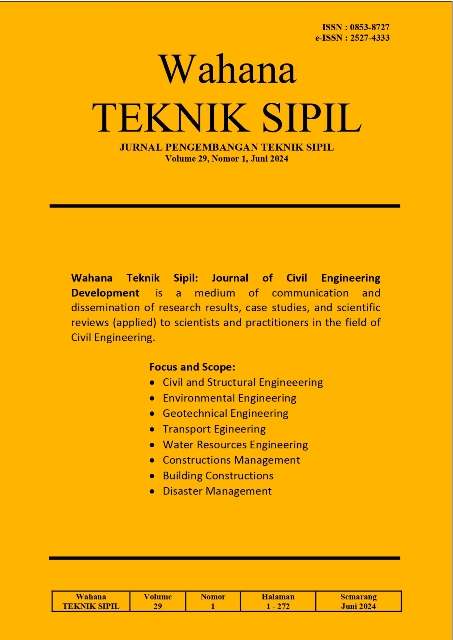DESAIN DAN VALIDASI MODEL BASIS DATA PEMELIHARAAN KOMPONEN ARSITEKTUR GEDUNG SEBAGAI PENDUKUNG FACILITY MAINTENANCE MANAGEMENT (FMM)
DOI:
https://doi.org/10.32497/wahanats.v29i1.5647Keywords:
Facility Maintenance Management, Database Model, Architectural Component MaintenanceAbstract
The problems that arise in Facility Maintenance Management (FMM) in Indonesia, which involve aspects of management, learning, and mutual understanding in the Common Data Environment (CDE), can be overcome one way by developing a database. To compile a good database, a database design method is required that is based on existing theories and standards. This research was conducted to design a database model with the scope of the object of architectural component maintenance of buildings starting from the stages of identifying needs, designing, and testing to users. The results of the study show that the database model obtained has the category of "very feasible" overall or partially in terms of service quality and material aspects. This also proves that proven methods and design techniques in providing accurate, non-overlapping, and efficient information needed in the management of material data, equipment, contractors, types of work, schedules, and costs during the maintenance and maintenance of architectural component buildings can be met properly through a relational database approach and verification and validation testing. For the development of science, especially Computational of Building Modeling Learning Technology, the results of this research provide a contribution in the form of a Database Model for Architectural Component Maintenance that can be applied in industry and education. It is recommended that this database design model be further developed into a Building Architectural Component Maintenance Information System.
References
Alnaggar, A., & Pitt, M., 2019, Towards a conceptual framework to manage BIM/COBie asset data using a standard project management methodology. Journal of Facilities Management, 17(2), 175”“187.
ARCHIBUS - People, Place and Purpose. (n.d.). ARCHIBUS.
Chen, C., & Tang, L., 2019, BIM-based integrated management workflow design for schedule and cost planning of building fabric maintenance. Automation in Construction, 107, 102944.
Chen, W., Chen, K., Cheng, J.C.P., Wang, Q., & Gan, V.J.L., 2018, BIM-based framework for automatic scheduling of facility maintenance work orders. Automation in Construction, 91, 15”“30.
Davtalab, O., 2017, Benefits of Real-Time Data Driven BIM for FM Departments in Operations Control and Maintenance. Computing in Civil Engineering 2017, 202”“210.
Elmasri, R., & Navathe, S., 2016, Fundamentals of database systems (6th ed). Addison-Wesley.
Ensafi, M., & Thabet, W., 2021, Challenges and gaps in facility maintenance practices. EPiC Series in Built Environment, 2, 237”“245.
Gao, X., & Pishdad-Bozorgi, P., 2019, BIM-enabled facilities operation and maintenance: A review. Advanced Engineering Informatics, 39, 227”“247.
Heaton, J., Parlikad, A.K., & Schooling, J., 2019, Design and development of BIM models to support operations and maintenance. Computers in Industry, 111, 172”“186.
HOME. (n.d.). EcoDomus.
Integrated Workplace Management System (IWMS) | FM: Systems. (2019, May 6).
Maximo Application Suite””Overview. (2021, March 26).
Moreno, J.V., Machete, R., Falcão, A.P., Gonçalves, A. B., & Bento, R., 2022, Dynamic Data Feeding into BIM for Facility Management: A Prototype Application to a University Building. Buildings, 12(5), Article 5.
NicaÅ‚, A.K., & WodyÅ„ski, W., 2016, Enhancing Facility Management through BIM 6D. Procedia Engineering, 164, 299”“306.
Revit | BIM Software | Autodesk Official Store. (n.d.).
Sadeghi, M., Elliott, J.W., Porro, N., & Strong, K., 2019, Developing building information models (BIM) for building handover, operation and maintenance. Journal of Facilities Management, 17(3), 301”“316.
Tekla Structural Designer. (2015, March 10). Tekla.
Downloads
Published
Issue
Section
License
Authors who publish with this journal agree to the following terms:Authors retain copyright and grant the journal right of first publication with the work simultaneously licensed under a Creative Commons Attribution License that allows others to share the work with an acknowledgement of the work's authorship and initial publication in this journal.
Authors are able to enter into separate, additional contractual arrangements for the non-exclusive distribution of the journal's published version of the work (e.g., post it to an institutional repository or publish it in a book), with an acknowledgement of its initial publication in this journal.
Authors are permitted and encouraged to post their work online (e.g., in institutional repositories or on their website) prior to and during the submission process, as it can lead to productive exchanges, as well as earlier and greater citation of published work (See The Effect of Open Access).






